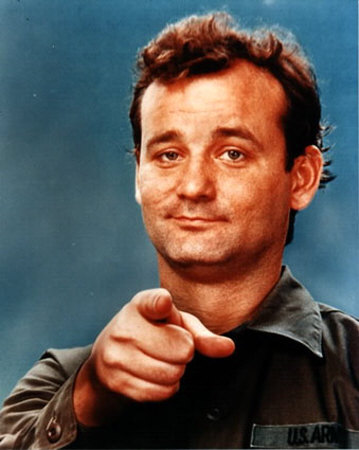A gentleman (and a lady) is someone who never makes someone else feel uncomfortable. That’s what cool is. Not what music you listen too, not what clothes you wear, Not who’s the most popular. … But the person who looks you in the eye, who’s always there, that’s the person you’ll remember from high school.
That was the message actor Bill Murray delivered to Manhattan High School students, alumni and hangers-on like me and Amy in between the girls and boys basketball games tonight.
Murray was in town to pay homage to former Manhattan High School attendee Del Close, who was inducted along with three others to the MHS wall of fame tonight. Close was regarded as a founder of improvisational comedy favored by Chicago’s Second City, where he mentored a long list of Saturday Night Live alumni, including Bill Murray. The night before Close died in 1999, he held a live wake in his hospital room and declared he was tired of being the funniest person in the room. He bequeathed his skull to the Goodman theatre for a performance of Shakespeare’s Hamlet (Alas, poor Yorick, I hardly knew thee).
 Murray was charming, heartfelt and funny as he paid homage to his late friend, and to the town of Manhattan (Kansas). His brother, Brian Doyle-Murray apparently lives in Manhattan (Kansas), although he’s in California working on a film, and there are stories of annual Murray brother sightings around town. Ask Kyle.
Murray was charming, heartfelt and funny as he paid homage to his late friend, and to the town of Manhattan (Kansas). His brother, Brian Doyle-Murray apparently lives in Manhattan (Kansas), although he’s in California working on a film, and there are stories of annual Murray brother sightings around town. Ask Kyle.
Afterwards, while Bill graciously talked to the locals, I got a chance to give him a barfblog and French Don’t Eat Poop T-shirt. He seemed amused (left).
Anyone who’s been here knows Manhattan (Kansas) really is in the middle of nowhere and really is in the middle of the contiguous 48 states. It’s not easy to get here. So yeah to Bill Murray.



.jpg)
 It seems like every week in the U.S. there is a report of unpasteurized milk testing positive for listeria or salmonella or E. coli or campylobacter or some other dangerous bug; every month there is a report of people, largely children, sickened after consuming unpasteurized milk.
It seems like every week in the U.S. there is a report of unpasteurized milk testing positive for listeria or salmonella or E. coli or campylobacter or some other dangerous bug; every month there is a report of people, largely children, sickened after consuming unpasteurized milk. We had our first, monthly, Food Science Café, last night, and while numbers were small, I still believe that, if you build it, they will come.
We had our first, monthly, Food Science Café, last night, and while numbers were small, I still believe that, if you build it, they will come..jpg) "Lots of people use it for whole birds or roasts, but I think it’s more important actually for the burgers and the ground beef," Powell said. "Ten years ago I would have never used one, but now I feel naked when I don’t – I feel vulnerable."
"Lots of people use it for whole birds or roasts, but I think it’s more important actually for the burgers and the ground beef," Powell said. "Ten years ago I would have never used one, but now I feel naked when I don’t – I feel vulnerable.".jpg) The
The  As Kansas State (24) prepares to host University of Kansas Saturday morning in college football action, here’s hoping the locals are better hosts than the women at KU’s Pi Beta Phi sorority.
As Kansas State (24) prepares to host University of Kansas Saturday morning in college football action, here’s hoping the locals are better hosts than the women at KU’s Pi Beta Phi sorority. In college football, the
In college football, the